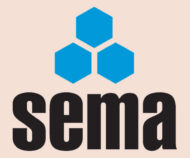Two questions this month, the first looks at spacing and the use of back stops and the second asks about cross beam deflection.
 Should Back stops be used as a safety precaution
Should Back stops be used as a safety precaution
Q. I am working with a company who have recently had their racking replaced to provide a 200mm clearance between the backs of the racking but there are concerns about the possibility of pallets being pushed off the racking behind. The company have suggested relying on training operators to put pallets away correctly to avoid this occurrence i.e. having a 30mm overhang at the front.
I believe this relies too heavily on the operator to get it right every time. Should the Company install backstops or wire mesh to prevent contact between the backs of pallets?
A. SEMA recommends that there should be a 50mm pallet overhang at the front and rear beams with the recommended clearance between the back-to-back pallets being at least 100mm.
If the spacing between the back-to-back racking has been correctly specified there should be sufficient space in the flue between the racks that it should not be possible to incorrectly place a pallet in one aisle and dislodge a pallet in the adjacent aisle; even if the front face of the pallet is flush with the front face of the beam, which a good operator would not do, this should still not dislodge a pallet in the next aisle.
It is difficult to comment on a specific site without a detailed knowledge of the operation and racking configuration. The SEMA Code for the Use of Static Pallet Racking (free download from the SEMA web site) states that SEMA do not recommend the use of back-stops because of the danger of structural damage. The SEMA code gives guidance on the necessary precautions if back-stops are fitted or being considered.
Cross – Beam Deflection
Q. We have recently erected racking & would like to confirm the maximum permitted cross-beam deflection on 1 tonne beams.
A. Generally beam deflection due to the safe working load will not exceed ‘Span/200’ as recommended in the SEMA Code of Practice for the Use of Static Pallet Racking (free copy available via the SEMA web site). The allowable vertical deflection is a ratio of the beam length so, for a 2700mm beam, this gives a maximum allowable deflection of 13.5mm.
A deflection of this magnitude is noticeable when looking along the aisle. However, this deflection is what is allowed in most of the codes of practice worldwide and the designer will have taken this into account when designing the product and will have ensured that an appropriate level of safety is present within the racking.
If you wish to check the deflection then you can do so from a taut string-line attached to the racking uprights just below the beam. Do not measure from the floor as the floor itself might not be level.
It is of course open to any purchaser of racking equipment to specify tighter deflection limits. Tighter deflection limits are sometimes required for automated equipment; however, they will normally lead to increased cost. For most types of forklift truck operated racking the ‘Span/200’ deflection limit is usually adequate.
SEMA Technical Enquiries
We hope you find the above articles, and those in previous editions, interesting. If you have a query send it to us by email to tq@sema.org.uk and we will do our best to have it answered by one of our technical experts.
SEMA Rack Safety Awareness Inspection Courses
SEMA runs a one-day safety course on Rack Safety Awareness and Inspection. These courses are aimed at end users, giving an in-depth look at the need for inspections, how to conduct an assessment and what actions to take when this is completed. These courses are held at the SEMA headquarters in Burntwood, Staffordshire, but arrangements can be made to hold them at the delegates’ premises.
SEMA Approved Rack Inspectors Qualification
This qualification is aimed at professionals who conduct rack surveys as an integral and significant part of their duties. It involves delegates in undertaking an in-depth SEMA Course, together with an examination and practical assessment. CPD will be an important part of the qualification, demonstrating to end users that SEMA Approved Inspectors maintain a high professional standard.
SEMA Publications
SEMA has 26 publications in stock – Codes of Practice, ‘Guides’ and European documents – all of which are available from our Offices. For further information on these documents contact SEMA or visit our website, www.sema.org.uk.
SEMA




Comments are closed.